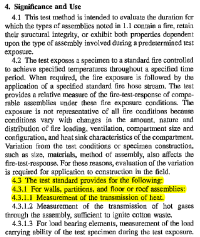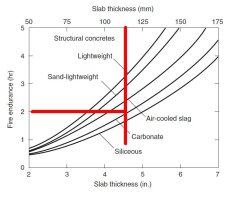I understand that for type IA construction the rating requirement for floor assemblies is 2 hours per ASTM E119.
I am not familiar with ASTM E119 and I am trying to find out if this 2hr requirement is just resistance (maintaining structural integrity) or it also refers to insulation.
I have an older (year 2000) copy of ASTM E119 and in the "Tests of floors and roofs" chapter, the conditions of acceptance include (31.1.2) which says that transmission of heat through the specimen during the classification period shall not have been such as to raise the average temperature on its unexposed surface more than 250 degrees Fahrenheit (139 Celsius) above its initial temperature.
This is an insulation requirement, right? In Europe we have a three letter classification such as REI120.
R = Load-bearing. The ability of a construction element to preserve its’ mechanical characteristics and the relevant load capacity during a normal fire.
E = Integrity. In other words, the structure’s ability to NOT allow the passage or production of gas or vapor to the area NOT exposed to the fire.
I = Thermal Insulation. To clarify, the ability of a structure to reduce within a temperature limit the transfer of heat to the unexposed (cold) side. The temperature limit is usually 140°C.
I am asking because one FP engineer in this project insists that ASTM E119 does does not have an insulation criteria and a R120/EI60 certified slab (Just 60 minutes' insulation) is acceptable for Type IA.
Is it correct that ASTM E119 sets no insulation requirement? This would mean that the floor temperature during a fire at the story below could ingnite carpets, furniture etc, on the story above the fire.
I am not familiar with ASTM E119 and I am trying to find out if this 2hr requirement is just resistance (maintaining structural integrity) or it also refers to insulation.
I have an older (year 2000) copy of ASTM E119 and in the "Tests of floors and roofs" chapter, the conditions of acceptance include (31.1.2) which says that transmission of heat through the specimen during the classification period shall not have been such as to raise the average temperature on its unexposed surface more than 250 degrees Fahrenheit (139 Celsius) above its initial temperature.
This is an insulation requirement, right? In Europe we have a three letter classification such as REI120.
R = Load-bearing. The ability of a construction element to preserve its’ mechanical characteristics and the relevant load capacity during a normal fire.
E = Integrity. In other words, the structure’s ability to NOT allow the passage or production of gas or vapor to the area NOT exposed to the fire.
I = Thermal Insulation. To clarify, the ability of a structure to reduce within a temperature limit the transfer of heat to the unexposed (cold) side. The temperature limit is usually 140°C.
I am asking because one FP engineer in this project insists that ASTM E119 does does not have an insulation criteria and a R120/EI60 certified slab (Just 60 minutes' insulation) is acceptable for Type IA.
Is it correct that ASTM E119 sets no insulation requirement? This would mean that the floor temperature during a fire at the story below could ingnite carpets, furniture etc, on the story above the fire.
Last edited:


